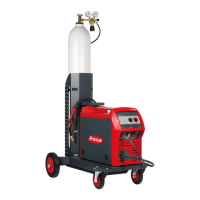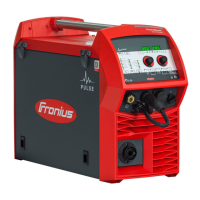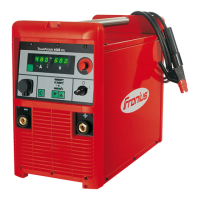75
EN
Pulse welding
Pulse welding Pulse welding is welding with a pulsing welding current. It is used for out-of-position weld-
ing of steel pipes or when welding thin sheets.
In these applications, the welding current set at the start of welding is not always ideal for
the whole welding process:
- if the amperage is too low, the base material will not melt sufficiently
- if overheating occurs, the liquid weld pool may drip.
Setting range: 1 - 990 Hz
Operating principle:
- A low base current I-G rises steeply to the significantly higher pulse current I-P and
drops back to the base current I-G after the Duty cycle dcY time.
- This results in an average current that is lower than the set pulse current I-P.
- During pulse welding, small sections of the welding location melt quickly and then rap-
idly re-solidify.
Activating pulse welding:
Set a value for the F-P setup parameter (pulse frequency)
NOTE! The power source controls the Duty cycle dcY parameter and base cur-
rent I-G according to the set pulse current (welding current) and pulse frequency.
Pulse welding - welding current curve
Adjustable parameters:
I-S = Starting current F-P = Pulse frequency (1/F-P = time
interval between two pulses)
I-E = Final current I-P = Pulse current (set welding cur-
rent)
Fixed parameters:
t
up
= UpSlope dcY = Duty cycle
t
Down
= DownSlope I-G = Base current
1/F-P
I-P
I-G
I
t
t
up
t
down
I-S
I-E
dcY
1

